Qingjie Liu
ContextQFormer: A New Context Modeling Method for Multi-Turn Multi-Modal Conversations
May 29, 2025Abstract:Multi-modal large language models have demonstrated remarkable zero-shot abilities and powerful image-understanding capabilities. However, the existing open-source multi-modal models suffer from the weak capability of multi-turn interaction, especially for long contexts. To address the issue, we first introduce a context modeling module, termed ContextQFormer, which utilizes a memory block to enhance the presentation of contextual information. Furthermore, to facilitate further research, we carefully build a new multi-turn multi-modal dialogue dataset (TMDialog) for pre-training, instruction-tuning, and evaluation, which will be open-sourced lately. Compared with other multi-modal dialogue datasets, TMDialog contains longer conversations, which supports the research of multi-turn multi-modal dialogue. In addition, ContextQFormer is compared with three baselines on TMDialog and experimental results illustrate that ContextQFormer achieves an improvement of 2%-4% in available rate over baselines.
GODBench: A Benchmark for Multimodal Large Language Models in Video Comment Art
May 16, 2025Abstract:Video Comment Art enhances user engagement by providing creative content that conveys humor, satire, or emotional resonance, requiring a nuanced and comprehensive grasp of cultural and contextual subtleties. Although Multimodal Large Language Models (MLLMs) and Chain-of-Thought (CoT) have demonstrated strong reasoning abilities in STEM tasks (e.g. mathematics and coding), they still struggle to generate creative expressions such as resonant jokes and insightful satire. Moreover, existing benchmarks are constrained by their limited modalities and insufficient categories, hindering the exploration of comprehensive creativity in video-based Comment Art creation. To address these limitations, we introduce GODBench, a novel benchmark that integrates video and text modalities to systematically evaluate MLLMs' abilities to compose Comment Art. Furthermore, inspired by the propagation patterns of waves in physics, we propose Ripple of Thought (RoT), a multi-step reasoning framework designed to enhance the creativity of MLLMs. Extensive experiments reveal that existing MLLMs and CoT methods still face significant challenges in understanding and generating creative video comments. In contrast, RoT provides an effective approach to improve creative composing, highlighting its potential to drive meaningful advancements in MLLM-based creativity. GODBench is publicly available at https://github.com/stan-lei/GODBench-ACL2025.
Towards Robust and Controllable Text-to-Motion via Masked Autoregressive Diffusion
May 16, 2025Abstract:Generating 3D human motion from text descriptions remains challenging due to the diverse and complex nature of human motion. While existing methods excel within the training distribution, they often struggle with out-of-distribution motions, limiting their applicability in real-world scenarios. Existing VQVAE-based methods often fail to represent novel motions faithfully using discrete tokens, which hampers their ability to generalize beyond seen data. Meanwhile, diffusion-based methods operating on continuous representations often lack fine-grained control over individual frames. To address these challenges, we propose a robust motion generation framework MoMADiff, which combines masked modeling with diffusion processes to generate motion using frame-level continuous representations. Our model supports flexible user-provided keyframe specification, enabling precise control over both spatial and temporal aspects of motion synthesis. MoMADiff demonstrates strong generalization capability on novel text-to-motion datasets with sparse keyframes as motion prompts. Extensive experiments on two held-out datasets and two standard benchmarks show that our method consistently outperforms state-of-the-art models in motion quality, instruction fidelity, and keyframe adherence.
SeriesBench: A Benchmark for Narrative-Driven Drama Series Understanding
Apr 30, 2025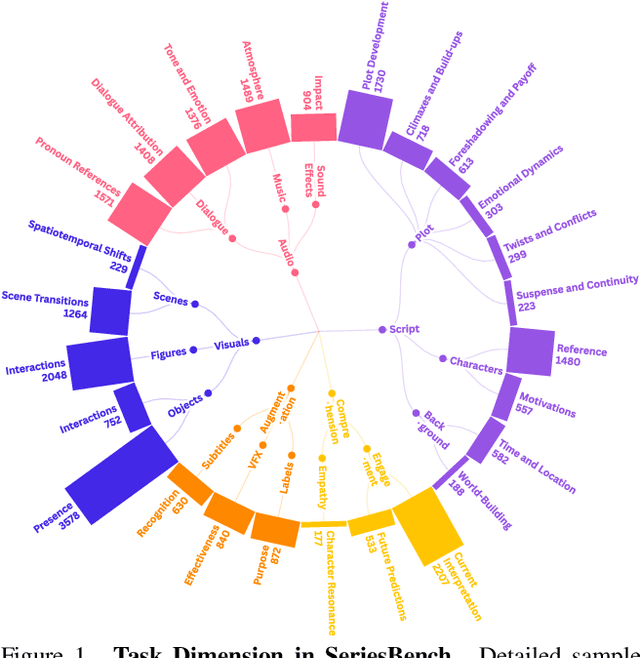
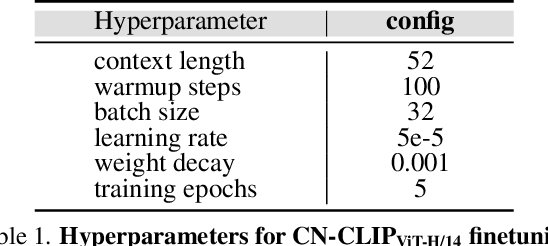
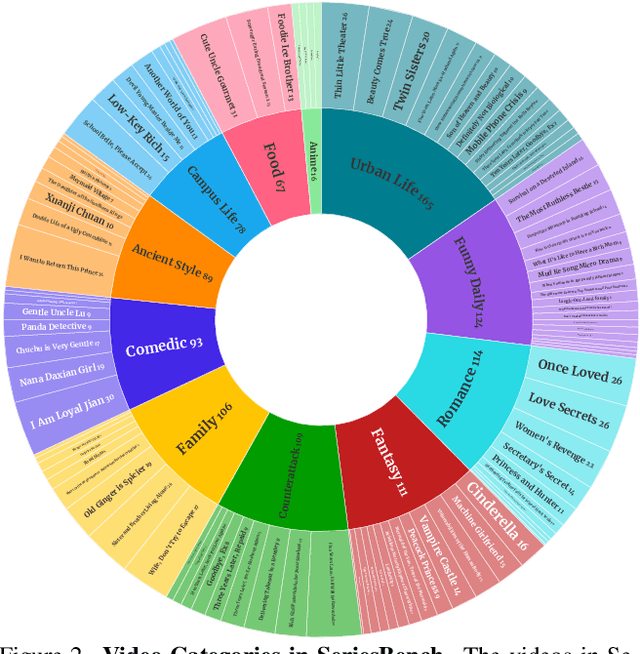
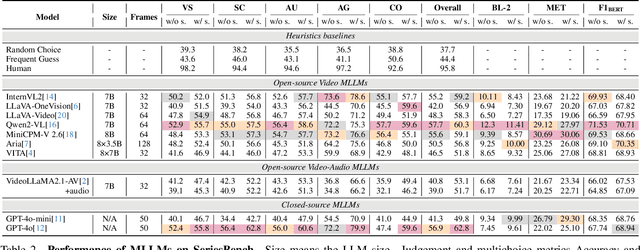
Abstract:With the rapid development of Multi-modal Large Language Models (MLLMs), an increasing number of benchmarks have been established to evaluate the video understanding capabilities of these models. However, these benchmarks focus on \textbf{standalone} videos and mainly assess ``visual elements'' like human actions and object states. In reality, contemporary videos often encompass complex and continuous narratives, typically presented as a \textbf{series}. To address this challenge, we propose \textbf{SeriesBench}, a benchmark consisting of 105 carefully curated narrative-driven series, covering 28 specialized tasks that require deep narrative understanding. Specifically, we first select a diverse set of drama series spanning various genres. Then, we introduce a novel long-span narrative annotation method, combined with a full-information transformation approach to convert manual annotations into diverse task formats. To further enhance model capacity for detailed analysis of plot structures and character relationships within series, we propose a novel narrative reasoning framework, \textbf{PC-DCoT}. Extensive results on \textbf{SeriesBench} indicate that existing MLLMs still face significant challenges in understanding narrative-driven series, while \textbf{PC-DCoT} enables these MLLMs to achieve performance improvements. Overall, our \textbf{SeriesBench} and \textbf{PC-DCoT} highlight the critical necessity of advancing model capabilities to understand narrative-driven series, guiding the future development of MLLMs. SeriesBench is publicly available at https://github.com/zackhxn/SeriesBench-CVPR2025.
SkeletonX: Data-Efficient Skeleton-based Action Recognition via Cross-sample Feature Aggregation
Apr 16, 2025Abstract:While current skeleton action recognition models demonstrate impressive performance on large-scale datasets, their adaptation to new application scenarios remains challenging. These challenges are particularly pronounced when facing new action categories, diverse performers, and varied skeleton layouts, leading to significant performance degeneration. Additionally, the high cost and difficulty of collecting skeleton data make large-scale data collection impractical. This paper studies one-shot and limited-scale learning settings to enable efficient adaptation with minimal data. Existing approaches often overlook the rich mutual information between labeled samples, resulting in sub-optimal performance in low-data scenarios. To boost the utility of labeled data, we identify the variability among performers and the commonality within each action as two key attributes. We present SkeletonX, a lightweight training pipeline that integrates seamlessly with existing GCN-based skeleton action recognizers, promoting effective training under limited labeled data. First, we propose a tailored sample pair construction strategy on two key attributes to form and aggregate sample pairs. Next, we develop a concise and effective feature aggregation module to process these pairs. Extensive experiments are conducted on NTU RGB+D, NTU RGB+D 120, and PKU-MMD with various GCN backbones, demonstrating that the pipeline effectively improves performance when trained from scratch with limited data. Moreover, it surpasses previous state-of-the-art methods in the one-shot setting, with only 1/10 of the parameters and much fewer FLOPs. The code and data are available at: https://github.com/zzysteve/SkeletonX
Vision-Language Model for Object Detection and Segmentation: A Review and Evaluation
Apr 13, 2025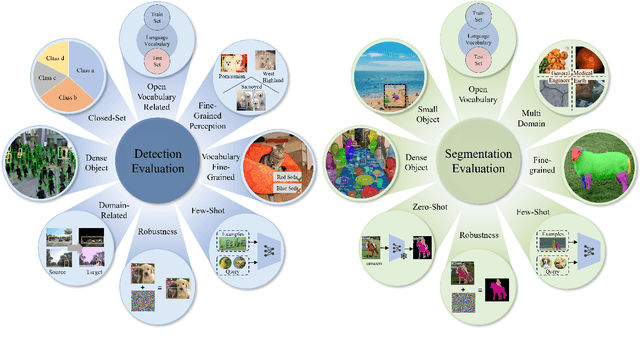
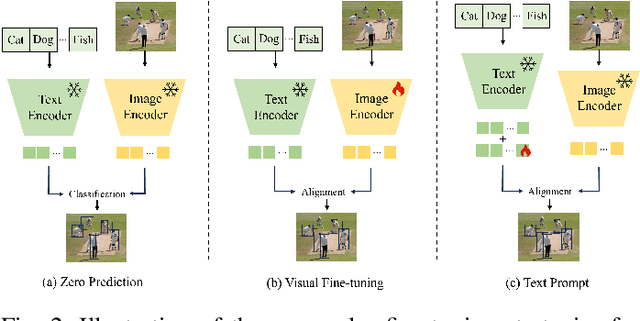
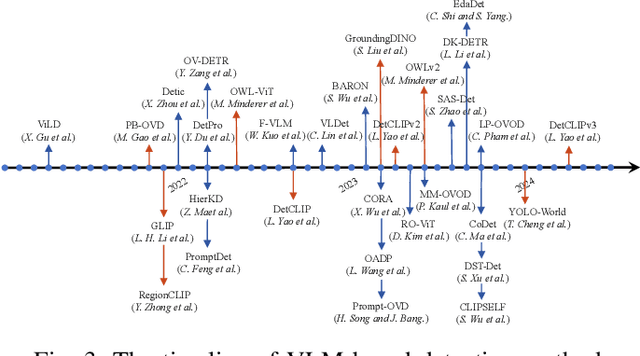
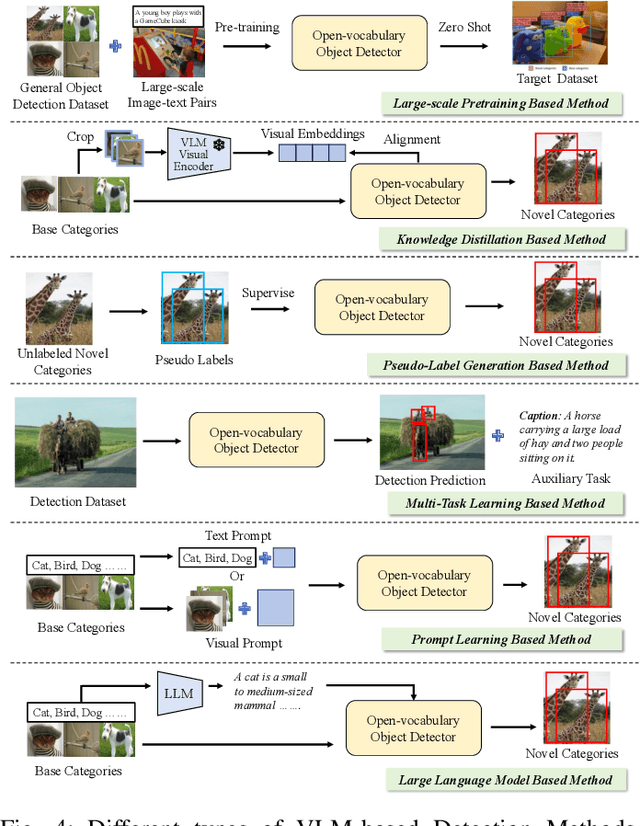
Abstract:Vision-Language Model (VLM) have gained widespread adoption in Open-Vocabulary (OV) object detection and segmentation tasks. Despite they have shown promise on OV-related tasks, their effectiveness in conventional vision tasks has thus far been unevaluated. In this work, we present the systematic review of VLM-based detection and segmentation, view VLM as the foundational model and conduct comprehensive evaluations across multiple downstream tasks for the first time: 1) The evaluation spans eight detection scenarios (closed-set detection, domain adaptation, crowded objects, etc.) and eight segmentation scenarios (few-shot, open-world, small object, etc.), revealing distinct performance advantages and limitations of various VLM architectures across tasks. 2) As for detection tasks, we evaluate VLMs under three finetuning granularities: \textit{zero prediction}, \textit{visual fine-tuning}, and \textit{text prompt}, and further analyze how different finetuning strategies impact performance under varied task. 3) Based on empirical findings, we provide in-depth analysis of the correlations between task characteristics, model architectures, and training methodologies, offering insights for future VLM design. 4) We believe that this work shall be valuable to the pattern recognition experts working in the fields of computer vision, multimodal learning, and vision foundation models by introducing them to the problem, and familiarizing them with the current status of the progress while providing promising directions for future research. A project associated with this review and evaluation has been created at https://github.com/better-chao/perceptual_abilities_evaluation.
A Survey on Remote Sensing Foundation Models: From Vision to Multimodality
Mar 28, 2025Abstract:The rapid advancement of remote sensing foundation models, particularly vision and multimodal models, has significantly enhanced the capabilities of intelligent geospatial data interpretation. These models combine various data modalities, such as optical, radar, and LiDAR imagery, with textual and geographic information, enabling more comprehensive analysis and understanding of remote sensing data. The integration of multiple modalities allows for improved performance in tasks like object detection, land cover classification, and change detection, which are often challenged by the complex and heterogeneous nature of remote sensing data. However, despite these advancements, several challenges remain. The diversity in data types, the need for large-scale annotated datasets, and the complexity of multimodal fusion techniques pose significant obstacles to the effective deployment of these models. Moreover, the computational demands of training and fine-tuning multimodal models require significant resources, further complicating their practical application in remote sensing image interpretation tasks. This paper provides a comprehensive review of the state-of-the-art in vision and multimodal foundation models for remote sensing, focusing on their architecture, training methods, datasets and application scenarios. We discuss the key challenges these models face, such as data alignment, cross-modal transfer learning, and scalability, while also identifying emerging research directions aimed at overcoming these limitations. Our goal is to provide a clear understanding of the current landscape of remote sensing foundation models and inspire future research that can push the boundaries of what these models can achieve in real-world applications. The list of resources collected by the paper can be found in the https://github.com/IRIP-BUAA/A-Review-for-remote-sensing-vision-language-models.
KwaiChat: A Large-Scale Video-Driven Multilingual Mixed-Type Dialogue Corpus
Mar 10, 2025Abstract:Video-based dialogue systems, such as education assistants, have compelling application value, thereby garnering growing interest. However, the current video-based dialogue systems are limited by their reliance on a single dialogue type, which hinders their versatility in practical applications across a range of scenarios, including question-answering, emotional dialog, etc. In this paper, we identify this challenge as how to generate video-driven multilingual mixed-type dialogues. To mitigate this challenge, we propose a novel task and create a human-to-human video-driven multilingual mixed-type dialogue corpus, termed KwaiChat, containing a total of 93,209 videos and 246,080 dialogues, across 4 dialogue types, 30 domains, 4 languages, and 13 topics. Additionally, we establish baseline models on KwaiChat. An extensive analysis of 7 distinct LLMs on KwaiChat reveals that GPT-4o achieves the best performance but still cannot perform well in this situation even with the help of in-context learning and fine-tuning, which indicates that the task is not trivial and needs further research.
OpenRSD: Towards Open-prompts for Object Detection in Remote Sensing Images
Mar 08, 2025Abstract:Remote sensing object detection has made significant progress, but most studies still focus on closed-set detection, limiting generalization across diverse datasets. Open-vocabulary object detection (OVD) provides a solution by leveraging multimodal associations between text prompts and visual features. However, existing OVD methods for remote sensing (RS) images are constrained by small-scale datasets and fail to address the unique challenges of remote sensing interpretation, include oriented object detection and the need for both high precision and real-time performance in diverse scenarios. To tackle these challenges, we propose OpenRSD, a universal open-prompt RS object detection framework. OpenRSD supports multimodal prompts and integrates multi-task detection heads to balance accuracy and real-time requirements. Additionally, we design a multi-stage training pipeline to enhance the generalization of model. Evaluated on seven public datasets, OpenRSD demonstrates superior performance in oriented and horizontal bounding box detection, with real-time inference capabilities suitable for large-scale RS image analysis. Compared to YOLO-World, OpenRSD exhibits an 8.7\% higher average precision and achieves an inference speed of 20.8 FPS. Codes and models will be released.
PACF: Prototype Augmented Compact Features for Improving Domain Adaptive Object Detection
Jan 15, 2025Abstract:In recent years, there has been significant advancement in object detection. However, applying off-the-shelf detectors to a new domain leads to significant performance drop, caused by the domain gap. These detectors exhibit higher-variance class-conditional distributions in the target domain than that in the source domain, along with mean shift. To address this problem, we propose the Prototype Augmented Compact Features (PACF) framework to regularize the distribution of intra-class features. Specifically, we provide an in-depth theoretical analysis on the lower bound of the target features-related likelihood and derive the prototype cross entropy loss to further calibrate the distribution of target RoI features. Furthermore, a mutual regularization strategy is designed to enable the linear and prototype-based classifiers to learn from each other, promoting feature compactness while enhancing discriminability. Thanks to this PACF framework, we have obtained a more compact cross-domain feature space, within which the variance of the target features' class-conditional distributions has significantly decreased, and the class-mean shift between the two domains has also been further reduced. The results on different adaptation settings are state-of-the-art, which demonstrate the board applicability and effectiveness of the proposed approach.
 Add to Chrome
Add to Chrome Add to Firefox
Add to Firefox Add to Edge
Add to Edge